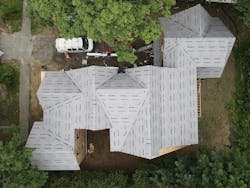Building Envelope Trends for 2025
With 2024 behind us it’s natural to wonder what’s in store for the year to come. Across residential construction, continued attention toward high-performance homes is driving efforts to design building envelopes with increased energy efficiency and greater durability.
Here are a few of the trends Benjamin Obdyke officials are seeing for 2025.
Resilience
The growing threat of wildfires and hurricanes has homeowners and builders alike seeking techniques and materials that can withstand increasing weather extremes. This includes fire-resistant cladding, decking, and roofing materials, such as those with WUI (Wildland Urban Interface) compliance, and siding and roofing options with high wind-resistance ratings. Robust envelope designs that help bulk water drain away also are key. On the roof, a self-adhered underlayment like VaporDry SA can provide some initial protection in case shingles are blown off during storms.
A systems approach to energy efficiency
The 2021 International Residential Code, which brings greater energy-efficiency requirements, is starting to be adopted in more jurisdictions around the country. In the past, tighter homes meant less drying potential in the wall system, leading to moisture problems; today, more builders and remodelers are recognizing the possibility of failures from water intrusion and are putting a larger percentage of their construction budget toward weatherization, including for HERS raters, building science consultants, and computer modeling to help design building envelopes with a systems approach that increases efficiency while also managing moisture and preserving indoor air quality.
Rainscreen requirements for stone veneer and stucco
Another change in the 2021 code is a requirement for using rainscreens behind manufactured stone veneer cladding and stucco. A full ventilated drying space is essential behind absorptive claddings such as those. A ventilated rainscreen incorporates an opening at the top of the wall as well as the typical opening at the bottom, creating a convective air flow that helps further dry the cavity.
Continuous insulation
The 2021 building code also requires continuous exterior insulation in Climate Zones 4 and above. Installing continuous insulation to the exterior of the building envelope can add an extra R-5 insulation value while helping to eliminate thermal breaks. It’s important to factor in how the addition of exterior foam board can affect the installation of weather resistive barriers and flashing.
Conditioned Attic Spaces
With the ongoing move toward more energy-efficient homes, conditioned attics have become more common. These spaces often are not designed with proper vapor permeability nor adequate ventilation, which can lead to trapped moisture, condensation, and eventually mold and rot on wood sheathing and premature roof failure. For homes with conditioned attics, a vapor-permeable underlayment like VaporDry SA can allow moisture to escape to help keep the roofing system dry.
